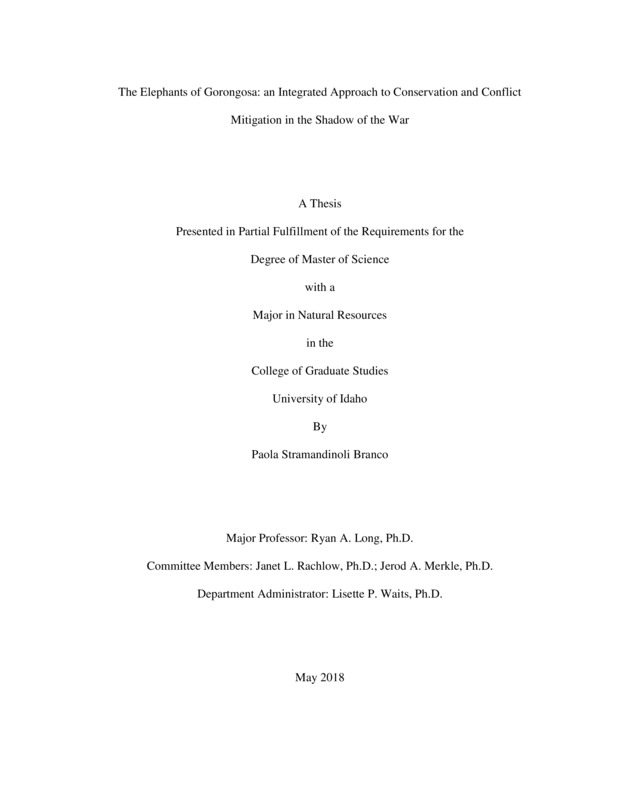The Elephants of Gorongosa: an Integrated Approach to Conservation and Conflict Mitigation in the Shadow of the War
Stramandinoli Branco, Paola. (2018-05). The Elephants of Gorongosa: an Integrated Approach to Conservation and Conflict Mitigation in the Shadow of the War. Theses and Dissertations Collection, University of Idaho Library Digital Collections. https://www.lib.uidaho.edu/digital/etd/items/stramandinolibranco_idaho_0089n_11364.html
- Title:
- The Elephants of Gorongosa: an Integrated Approach to Conservation and Conflict Mitigation in the Shadow of the War
- Author:
- Stramandinoli Branco, Paola
- ORCID:
- 0000-0002-7921-1753
- Date:
- 2018-05
- Keywords:
- crop-raiding elephants Gorongosa green wave human-elephant conflic mitigation strategies
- Program:
- Natural Resources
- Subject Category:
- Wildlife conservation; Wildlife management; Biology
- Abstract:
-
The recovery of Gorongosa National Park’s elephant population from decimation by war is an unparalleled conservation success story. Yet, a concomitant increase in crop-raiding by elephants along the boundaries of the Park now threatens to undo restoration efforts. Our project is the first to analyze the frequency, severity and distribution of raiding events around Gorongosa, and to experimentally evaluate strategies for reducing crop damage. We combined data on movements of crop-raiding elephants with data on crop availability, patterns of precipitation, NDVI, and the nutritional quality of natural versus cultivated forages to model the drivers of spatiotemporal variation in crop-raiding behavior by elephants. In addition, after one year of tracking the movements of crop-raiding elephants with GPS collars we identified 13 key crossing points used by elephants to exit the Park and access crops. We then experimentally tested three different strategies for deterring elephants from leaving the Park to raid crops at those locations: beehive fences, chili fences, and a combination of both (“spicy beehive fences”). In addition to using GPS collar data to quantify elephant responses to the fences, we trained two teams of local community members to collect quantitative data on crop damage by elephants and to help construct and maintain the experimental fences. We also installed 24 camera traps around the fences to document elephant behavior in proximity to each fence type. Elephants strategically altered their foraging behavior in natural versus cultivated landscapes, ostensibly to increase their intake of high-quality food in both environments. Specifically, elephants actively switched from “surfing the green wave” when foraging inside the Park to selecting mature crops that were browning down outside the Park as they moved between natural and cultivated landscapes. Our mitigation experiment revealed that elephants significantly avoided areas with beehive fences and chili fences, although all fence types increased the probability that elephants would return to the Park rather than continue on to raid crops after encountering a fence. The magnitude of this effect was greatest for the beehive fences, followed by the spicy beehive fences and fake beehives (beehive control). These results have important implications for reducing human-elephant conflict in Africa, and for helping to facilitate both the conservation of this iconic keystone species and the livelihoods of the many farmers who live in close proximity to them.
- Description:
- masters, M.S., Natural Resources -- University of Idaho - College of Graduate Studies, 2018-05
- Major Professor:
- Long, Ryan A
- Committee:
- Rachlow, Janet L; Merkle, Jerod A
- Defense Date:
- 2018-05
- Identifier:
- StramandinoliBranco_idaho_0089N_11364
- Type:
- Text
- Format Original:
- Format:
- application/pdf
- Rights:
- In Copyright - Educational Use Permitted. For more information, please contact University of Idaho Library Special Collections and Archives Department at libspec@uidaho.edu.
- Standardized Rights:
- http://rightsstatements.org/vocab/InC-EDU/1.0/

